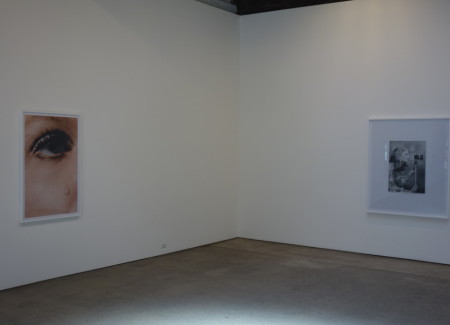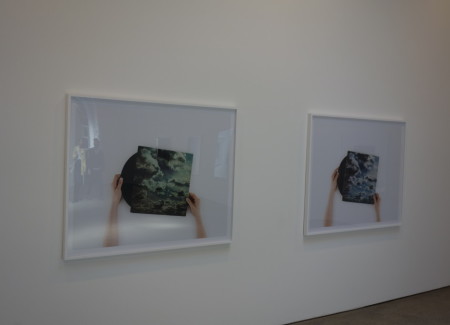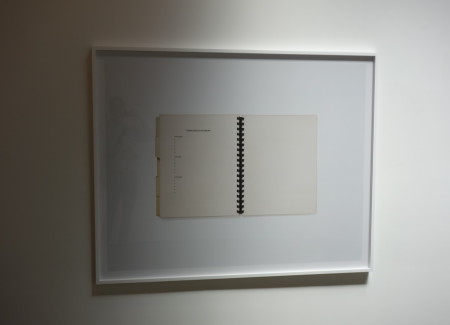JTF (just the facts): A total of 14 large scale color photographs, framed in white and unmatted, and hung against white walls in the main gallery space and the smaller back gallery. All of the works are c prints, made in 2016. Physical sizes are roughly 47×60, 50×53, 50×59, 50×63, 53×35, 56×50, and 89×71, and all of the prints are available in editions of 5+2AP. An artist’s book entitled Woman Crying was recently published by Hassla Books (here) and is available from the gallery for $20. (Installation shots below.)
Comments/Context: Anne Collier’s recent photographs find her simultaneously expanding several lines of artistic thinking, continuing to explore further down paths she has visited before and allowing some to branch off in new evolutionary directions. Her show is a bit like catching up with a family friend whom you haven’t seen in a while – there are updates for each and every daughter and son in the brood, with some still doing what they’ve always done and others off on exciting new tangents.
Collier’s particular brand of appropriation remains rooted in context – in many ways, she’s doggedly pursuing an approach contrary to the snatch and grab ethic of the digital Internet, where images are routinely unmoored from their original surroundings and recombined in alternate forms. Collier’s works are more about physical isolation and attention than they are about source material rework – she’s keen to make us look harder at the things she’s found, as she found them, forcing us to unpack the influences and cultural meanings that the in situ images represent. She’s proven again and again that magazine spreads, album covers, daybook pages, and other printed ephemera all have stories to tell and biases to show if we are willing to engage them with patience and analytical precision.
Collier has already had plenty of success exposing the absurdity of the male gaze and related female roles in her series of images depicting women and cameras, and three new works thoughtfully continue that investigation. One shows a woman photographer in profile, and while her camera seems plausibly set up, her billowing floral shirt seems oddly out of place – while it may simply represent the fashions of the times, from a position looking back several decades, it feels like staged femininity and implied frilliness rather than hard edged professionalism. The other two new works in this genre are even more ridiculous and confrontational. Up close camera and lens equipment stills are paired with soft core nudes with bared breasts and seductive sexualized poses, as if these were the kind of images the (implied) male photographer would like to be making and would be able to take if only he had the right gear. These works surgically disassemble the male gazes and accepted attitudes of advertiser and customer alike, leaving behind a sense of head-shaking astonishment that such ads really did run in some now-dated camera magazine. As examples of Collier’s interest in subtle but insidious gender prejudice, they are pricelessly perfect.
Collier taps into an adjacent vein of this thinking with her series of tightly cropped works of women crying. While there is one full album cover of this subject (from the movie version of For Whom the Bell Tolls) that perhaps began this conceptual conversation, the rest of the works narrow down to just one enlarged female eye, each with a tear dripping down the cheek. Unlike Alex Prager’s recent exaggeratedly emotional film noir eyes, Collier’s eyes seem to be filled with melancholy tears and quiet enduring pain – there are no agonizing or dramatic arms-flailing sobs on view here. But the emotions displayed on these album covers (from the late 1960s to the early 1980s, one of which is recognizably Astrid Gilberto) also feel wholly manufactured and manipulated, with a crying-on-cue kind of staged sadness, which of course brings us back to Collier’s interest in the fixed preconceptions for how women were/are expected to act. The works expose this subdued and controlled crying as the sham that it was, yet another facet of an invisible superstructure of rigid female roles and acceptable behaviors embedded in everyday popular culture.
Collier’s other new works include a paired study of album cover clouds (in hints of green and blue), an open book spread of two toned waves, and a notebook with breezy motivation slots for “Things I Want to Accomplish” in handy increments (6 months, 5 years, 20 years). But once you’ve adopted Collier’s questioning mindset, each of these seems to offer layers of underlying whys that spin off in all directions. Were the album clouds faded by the sun or deliberately made in alternate colors? And if the choice was overt, what do the two colors imply? A large female nude in the waves in the back room opens up similar questions. As another visitor standing next to me cooed into her phone over how lovely this image was, I was thinking – is this sun kissed bikini-bottomless model a version of a stereotypical female ideal, a surfer’s Venus on the half shell? And with that reaction, I knew Collier had me. Down the cerebral rabbit hole we went, looking at each found image with a newly context-sensitive and actively skeptical set of eyes.
Given the breadth of this show and coming off her recent inclusion in the Guggenheim’s Photo-Poetics survey (here), it’s clear that Collier has hit her stride. Her point of view has become increasingly crisp and differentiated, and her found examples have taken on tighter resonances. This feels like one of those pivot point shows when an artist who has been gaining momentum over time consolidates her gains, solidifying the foundation for her next stage of ascendance.
Collector’s POV: The works in this show are priced at $20000, $24000, and $45000, based on size. Collier’s work has only just begun to find its way into the secondary markets, with recent prices ranging between roughly $11000 and $20000.












